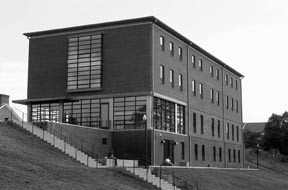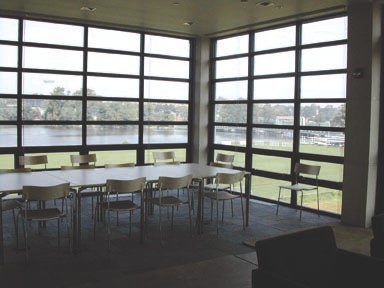St. John's Campus
Red Brick Buildings and Green Technology
By Beth Schulman
With its august history as one of the oldest colleges in the country and its renown as a bastion of the liberal arts, most people would not immediately identify St. John's College as a place for innovation. Founded in 1696 as King William's School-what we would today call a prep school-the school was established under its current name as a college by the State of Maryland in 1784. Today St. John's is known as the "great books" school, where students read the great works of Western civilization beginning with Homer's Iliad and ending with Einstein's theories.
 St. John's celebrated another milestone its 309-year history on November 11, 2004, when the college dedicated Gilliam Hall, the first new residence hall to open in 50 years. The 48-bed dormitory on the college's lower campus is named for the late James H. Gilliam Jr., who served as trustee of The Hodson Trust; the trust gave the college a $5 million grant for construction of the $7.5 million dormitory. The college estimates that it will spend approximately $20 million on student housing before construction is over, including Gilliam and another dormitory still under construction at $7.5 million each, and $2.7 million in renovations to existing residence halls. St. John's celebrated another milestone its 309-year history on November 11, 2004, when the college dedicated Gilliam Hall, the first new residence hall to open in 50 years. The 48-bed dormitory on the college's lower campus is named for the late James H. Gilliam Jr., who served as trustee of The Hodson Trust; the trust gave the college a $5 million grant for construction of the $7.5 million dormitory. The college estimates that it will spend approximately $20 million on student housing before construction is over, including Gilliam and another dormitory still under construction at $7.5 million each, and $2.7 million in renovations to existing residence halls.
The St. John's campus was built for a student population of 350, and enrollment now tops 450. Until this year, only one of the college's dormitories was built after the Civil War; the last time the college had dedicated a new dorm was in 1954 when Campbell Hall opened to house women after the previously all-male college went co-ed in 1951. In addition, rental prices within walking distance of the college have risen dramatically in the last several years, creating an off-campus housing shortage.
The college currently seeks to house at least 75 percent of its student population on campus. The second new dormitory which has yet to be named-situated directly across from Gilliam and virtually identical in appearance-will house another 32 students and provide much-needed faculty office space. It is expected to be completed by January 2006.
The architecture of the new dormitories will echo the modernism introduced on the historic campus with Mellon Hall, which was constructed in 1958. Dedicated by then-President Dwight D. Eisenhower, Mellon Hall is the creation of Richard Neutra, a modernist architect who studied with Frank Lloyd Wright. As the largest building on campus, it holds the auditorium, art gallery, student labs, music classrooms, and faculty and administrative offices. Deemed the most significant example of modern architecture in Annapolis by the Annapolis Historic Preservation Committee, Mellon Hall underwent a $12.9 million renovation completed in July 2002. Ziger/Snead Inc. of Baltimore served as the project architect, and Bovis Lend Lease, Inc. of Bethesda as the general contractor; the two firms are also responsible for the new dormitories.
The renovation of Mellon Hall garnered accolades for both its architecture and its construction. It won the 2003 award for excellence and construction in renovation over $5 million from the Association of Builders and Contractors, and it also won the 2004 Michael F. Trostel, FAIA, award of excellence in an historic preservation project for the Baltimore area. The project included an addition to the building for more faculty offices and a new faculty computing center, darkroom, pottery studio, air-conditioning system, and the creation of a new glass-fronted café, which extends into the courtyard off the lobby. A renovation of the auditorium included an all-new heating and air-conditioning system and other upgrades.
 The renovation was overseen by St. John's Treasurer Steve Linhard. As an environmentalist, he is most enthusiastic about the building's innovative cooling system, involving a thermal storage system with tanks in the basement. "We brought in a chiller that runs at night to chill water and glycol (antifreeze) to 26 degrees," says Linhard. "It's run at night because that costs half what it does during the day in the summer. It's considered a green or environmentally friendly system, by allowing power companies to distribute load among 24-hour periods instead of peak periods, thus reducing the need for higher capacity. So you don't have to build more power plants just because the peak at 2 p.m. is so high." The renovation was overseen by St. John's Treasurer Steve Linhard. As an environmentalist, he is most enthusiastic about the building's innovative cooling system, involving a thermal storage system with tanks in the basement. "We brought in a chiller that runs at night to chill water and glycol (antifreeze) to 26 degrees," says Linhard. "It's run at night because that costs half what it does during the day in the summer. It's considered a green or environmentally friendly system, by allowing power companies to distribute load among 24-hour periods instead of peak periods, thus reducing the need for higher capacity. So you don't have to build more power plants just because the peak at 2 p.m. is so high."
The buildings might be made of red brick, but clearly more than just the ivy on campus is green. Gilliam, the new 20,000 square-foot dormitory built on the College Creek side of the campus, uses an innovative geothermal heating and cooling system that will save money and conserve energy. The basic premise of geothermal systems is to use the earth's constant subsurface temperature of 51 to 55 degrees to provide more efficient heating and cooling. In winter, the system draws heat from the ground to heat buildings and in summer it extracts heat from buildings and draws cool from the ground. The Environmental Protection Agency has stated that geothermal systems are 40 percent more energy efficient than conventional air-to-air heat pumps.
The new building's geothermal heating and cooling system utilizes a group of 130 vertical wells, each drilled to a depth of 200 feet, as a heat-exchange medium. The drilling phase of the project temporarily turned the eastern plateau of the campus into something akin to a prairie dog colony, producing deep holes punctuated with mounds of sandy soil, but the gains will be lasting: the system is expected to pay for itself in around five years. "Here again we were looking for ways to reduce the long term cost of providing heating and cooling," says Linhard.
The main concern of project architect Joseph Cellucci was to integrate the new residence halls into the wider community, both architecturally and socially. A number of elements link the new construction to the older buildings on the upper campus: in Gilliam Hall, the proportions of the window openings reference McDowell Hall, and the glass-enclosed common rooms echo the glass-walled lobby of Francis Scott Key Auditorium in Mellon Hall.
"Because St. John's is a close-knit community, it was important to integrate these residence halls into the wider community," says Cellucci. To that end, both formal and informal gathering spaces were incorporated into the design: a courtyard to be built between the two residence halls creates a central meeting place. A low brick wall, brick paving, and a small pavilion built alongside the creek, all aligned with the Quad and planetarium of Mellon Hall, provide a waterside retreat for quiet conversation or solitary reading. In addition, a series of terraces along the steps from Gilliam to the lower playing field offers an additional place to sit and enjoy the view.
And according to Cellucci, the geothermal field greatly reduces energy consumption and eliminates the need for large mechanical equipment on the site. "Long-term, it's so sensible for the school, because you're basically off-grid. It's going to save a lot of money," while initially more expensive to install than a traditional heating and cooling plant.
"It's a tribute to the college that they're looking at ways to build green," says St. John's Director of Operations Don Jackson. Recently hired by the school to manage new construction and renovation work after 25 years at the Chesapeake Bay Foundation, Jackson adds, "I'm excited to be doing what I can to contribute to that goal." While committed to providing a classical education in the liberal arts, it would seem that St. John's College is at the cutting edge when it comes to energy use.
Back
|

